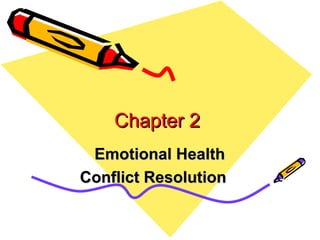Ch 2 sec 2 a
- 1. Chapter 2Chapter 2 Emotional HealthEmotional Health Conflict ResolutionConflict Resolution
- 2. Conflict âĒ Struggle or opposition between people.
- 3. Tolerance âĒ Accepting differences between one-self and others.
- 4. Conflict Resolution Strategies âĒ Giving in âĒ Walking away âĒ Doing nothing âĒ Fighting dirty âĒ Constructive problem solving
- 5. Give In âĒ Example: Tommy gives his lunch money to Joey every day. In return he does not get beat up. âĒ + saves time âĒ + allows for bargaining âĒ - person may feel cheated âĒ - may lead to bullying
- 6. Walk Away âĒ Example: Jill tries to start a fight with Jody and Jody just walks away from the fight. âĒ + allows time for cooling off âĒ + Avoids physical violence âĒ - conflict still not solved âĒ - problem may worsen
- 7. Do Nothing âĒ Example: Someone cuts in front of you at the checkout counter during school lunch. âĒ + Time will solve the problem âĒ + Avoids conflict or violence âĒ - Hostility may grow/ resentment builds âĒ - Problem may get worse
- 8. Fighting Dirty âĒ Example: Karen cries to her boyfriend so she can manipulate him and get what she wants. âĒ + NO positives âĒ - worsens the conflict âĒ - clouds the issue.
- 9. Constructive Problem Solving âĒ Example: Tom wants to go to a movie and Jill wants to go out to dinner. Solution they agree to have dinner and a movie at home. âĒ + Problem stays solved âĒ + Everyone gets something âĒ - Takes time and effort âĒ - Everyone needs to compromise
- 10. Constructive Problem Solving âĒ Example: Tom wants to go to a movie and Jill wants to go out to dinner. Solution they agree to have dinner and a movie at home. âĒ + Problem stays solved âĒ + Everyone gets something âĒ - Takes time and effort âĒ - Everyone needs to compromise









